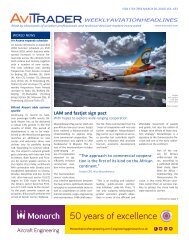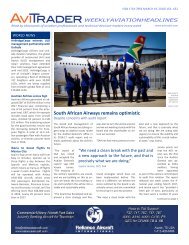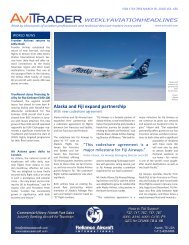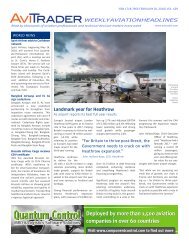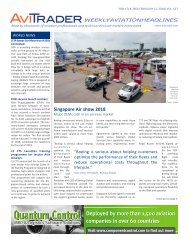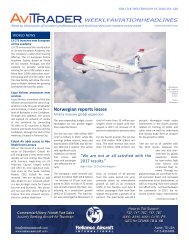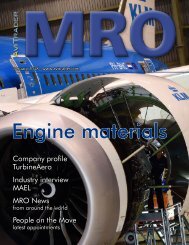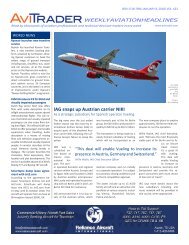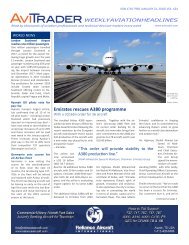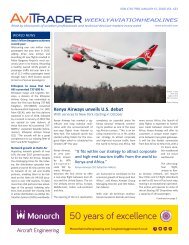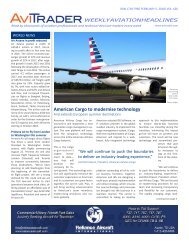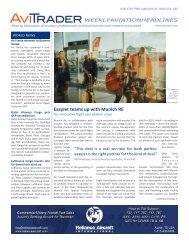AviTrader_Monthly_MRO_e-Magazine_2017-10
AviTrader_Monthly_MRO_e-Magazine_2017-10
AviTrader_Monthly_MRO_e-Magazine_2017-10
You also want an ePaper? Increase the reach of your titles
YUMPU automatically turns print PDFs into web optimized ePapers that Google loves.
Cover story: Maintenance technical training<br />
23<br />
type rating will define the critical quantity. The problem itself lies in the<br />
ability to offer type rating courses at a fast speed. OJT requirements,<br />
among others, can become a bottleneck, “Schlag explains.<br />
Schlag feels there is also a non-convergence between the general development<br />
in the educational and labour market and the aircraft maintenance<br />
industry, where the general public is not sufficiently informed<br />
about the needs and developments of the industry. “We think that if<br />
young people had more information on this, more students would consider<br />
a career in our industry through vocational training,” he says.<br />
In Helsinki, Finland, maintenance training is a part of Finnair technical<br />
operations. Aircraft type courses are targeted for Finnair maintenance<br />
personnel and the training portfolio have been focused to the types<br />
Finnair operates, recently mainly on A350. The A350 type course concept<br />
follows the manufacturer’s standards. The scope of maintenance<br />
type courses covers the A350, A330, A340, A320-series and E190<br />
aircraft types.<br />
Finnair has been independent with its technical training performing all<br />
the needed training mostly in-house. The scope of maintenance training<br />
portfolio includes also the needed mandatory basic and continuations<br />
training such as human factors, EWIS, FTS and individual aircraft<br />
type related continuation training.<br />
Finnair’s fleet is currently growing and this challenges also the training organisation<br />
to provide enough qualified personnel for maintaining the fleet.<br />
Samu Linnimaa, Manager, Process and Competence<br />
Development at Finnair Technical Operations.<br />
needed in the future.<br />
<strong>MRO</strong>s will need to embrace<br />
new technologies<br />
to advance maintenance<br />
technical training. Maintenance<br />
technicians at<br />
AAR are trained to use<br />
proprietary predictivemaintenance<br />
software to<br />
reduce the likelihood of<br />
an unexpected parts failure.<br />
“Using big data and<br />
algorithms, we are able to<br />
identify with greater accuracy<br />
when a part on a particular airframe might need servicing so that<br />
we can proactively source the replacement and dispatch it closer to the<br />
customer before a failure occurs,” says Dellinger.<br />
In addition, AMTs can access AAR’s digital supply chain, which provides<br />
touch-of-the-fingertips transparency into parts availability at<br />
OEMs (original equipment manufacturers) and other locations around<br />
the world. “This technology enables our crews to reduce the time between<br />
a part failure and a replacement being identified, paid for and<br />
shipped, and that plane taking off again, safely,” Dellinger adds.<br />
Partnering with technical institutions has been invaluable for the folks<br />
at AAR. “We have formed public-private partnerships in communities<br />
near each of AAR’s five aircraft maintenance centres in North America<br />
to create a talent pipeline, “Dellinger continues.<br />
For instance, he says one the reasons AAR built a new state-of-the-art<br />
wide-body hangar in Rockford, Illinois, was an agreement with Rock<br />
Valley Community College to enhance their training programme. Rock<br />
Valley built a 40,000-square-foot training centre on the Rockford airport<br />
to train more A&P mechanics. Once fully operational, the facility<br />
will create about 500 jobs.<br />
There is need to widen the competence<br />
of maintenance staff.<br />
Samu Linnimaa, Manager, Process and Competence Development at<br />
Finnair Technical Operations says certain competence and skills gaps<br />
have been recognised within Finnair. “There are number of skilled<br />
people retiring in the coming years. Also growing number of A350<br />
aircraft equipped with modern technology requires different skills than<br />
the legacy fleet. This all requires action and a proper plan for the training<br />
organisation to fill the gaps and maintain the critical skills.”<br />
Linnimaa, points that the needed expertise are mainly in the field of<br />
special skills such as NDT, composite, sheet metal, software management,<br />
specialised B2-skills such as fibre optics repair.<br />
He says there are several ways to respond to the demand. “The most<br />
common way to widen the competence of maintenance staff will be by<br />
training, OJT, job rotation or recruitments. Trainings for special skills<br />
are usually tailored courses either build in-house or arranged with<br />
partner organisations or colleges,” Linnimaa indicates. Finnair Tech<br />
Ops participates actively in various kinds of forums both nationally<br />
and internationally, discussing the skills and competences seen and<br />
AAR has already hired 25 Rock Valley graduates as Support Technicians<br />
– “and we’ve committed to grant an interview to anyone who<br />
matriculates through their programme. Previously, the aviation maintenance<br />
programme at Rock Valley maxed out at around 30 or 40 students.<br />
Now, due to solid recruiting initiatives, the new training centre<br />
and a dedicated employer, the programme is completely full, with 170<br />
students.”<br />
AAR has developed similar partnerships at other sites including Oklahoma<br />
and Indianapolis.<br />
When looking new technologies to improve training, Siddique from<br />
Lufthansa Technical begins<br />
first by discussing basic<br />
and competence training.<br />
“Generally we see a trend<br />
that more and more classroom<br />
trainings are completely<br />
or partially replaced<br />
by web-based training elements.”<br />
Siddique notes though that<br />
regulation is still limiting<br />
the extensive use of such<br />
WBTs in approved programmes.<br />
“Type Training<br />
Rubin Siddique, CEO Lufthansa Technical Training<br />
<strong>AviTrader</strong> <strong>MRO</strong> - October <strong>2017</strong>





